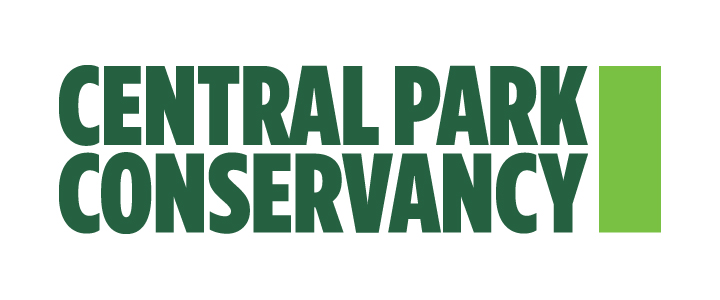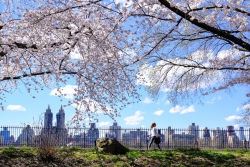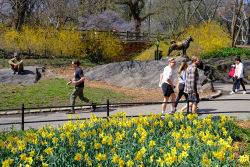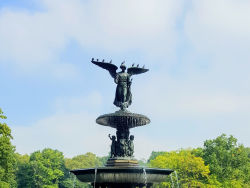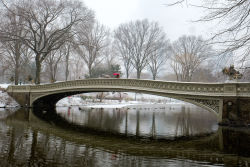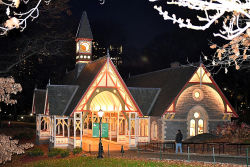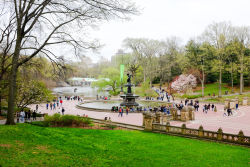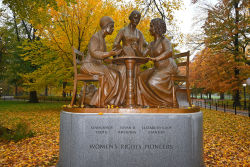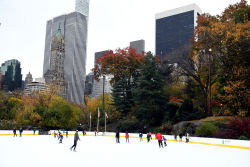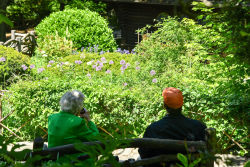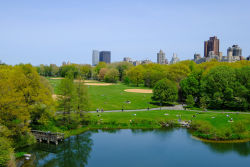Central Park
The Daily Plant : Thursday, April 6, 2006
Parks And The ASPCA : Bringing Horses To Water For 140 Years
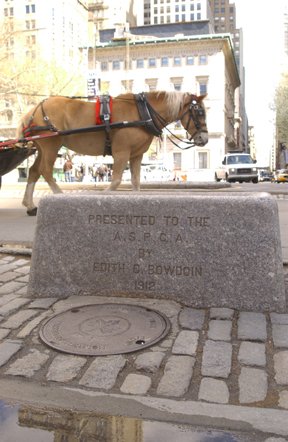
photo by John Mattera
It was only about 100 years ago that automobiles began to outpace the tried and true horse as a means of transportation around the City. Until that time horses meant as much to maintaining life and commerce in the City as do the cars, buses and trucks of today. Going back 140 years, when New York City consisted of just Manhattan, the population exceeded 800,000. For the most part, those people lived below 14th Street. Today the population of Manhattan falls just short of double the 1860 figure (1.5 million as of 2004), but those people are distributed over the entire 13-mile length of the island.
The crowding of mid-nineteenth century New York led to the Parks Movement. At practically the same time, many New Yorkers became concerned with the way that those horses living and working in the City were treated. In February of 1866, a European aristocrat named Henry Bergh came to New York. Bergh had stopped off in England to meet with the Earl of Harrowby, who had founded England’s Royal Society for the Prevention of Cruelty to Animals. On February 8, 1866, he gave a speech in New York that aimed to expose the plight of animals into the public conscience.
Bergh received attention in the press and support for his "Declaration of the Rights of Animals" from key figures in New York’s high society. Moving with now-unheard-of speed, on April 10, 1866, the State Legislature passed the charter incorporating the American Society of the Prevention of Cruelty to Animals (ASPCA). On April 19, they passed an anti-cruelty law, and put the ASPCA in charge of enforcing it. In addition to making sure that people did not beat their draft horses, the ASPCA invented slings to lift injured horses, made sure New York’s slaughterhouses followed the approved procedures of the day, and even installed horse drinking fountains around the City.
Although construction of Central Park began before 1866, the Park was far from finished when the ASPCA and its new regulations came into effect. Parks took the initiative to add a beautiful horse drinking fountain into Central Park. These plans are discussed, in detail, for the first time in a report found in the Minutes of the Board of Commissioners of the Department of Public Parks dated May 19, 1870. Architect-in-Chief Jacob Wrey Mould described his elaborate plans for the fountain in this "Report on the Structures Now in Progress and their Cost." According to Mould, this granite and bronze fountain was to be situated "on the circle northwest of the Mall." His estimate for the fountain came to $4,950 (more than $108,000 in today’s money), and more than half of that was for a "bronze ornamental terminal and fountain." The Park that turned democratic ideals into landscaped realities for the people likewise would spare no expense in the treatment of its horses. This fountain was restored in recent history and the picturesque site is now known as Cherry Hill.
Today Central Park survives almost as a historical preserve for the nineteenth century equine society. Where else can you take a walk on a cobblestone path and have a horse trot by? The ASPCA sited the horse fountain (pictured) in Central Park in 1912, by which time the sight of reins around the town had given way to the reign of the automobile. So, if you’ve got a horse, Central Park is just about the only place you can bring it to water….making it drink, however, is entirely your responsibility.
Written by John Mattera
PARKS REMEMBERS WAYNE DARRELL EDWARDS
We are saddened to report the passing of Wayne Darrell Edwards. Wayne passed away on March 25 at the age of 46. A dedicated Parks employee for 26 years, Wayne served as Deputy Center Manager at Williamsbridge Oval Recreation Center in the Bronx. He touched the lives of his family, friends, co-workers and hundreds of youth that he mentored. Wayne will be deeply missed.
QUOTATION FOR THE DAY
"I can’t understand why I flunked American history. When I was a kid there was so little of it."
George Burns
(1896 – 1996)
Check out your park's Vital Signs
Clean & Safe
Green & Resilient
Empowered & Engaged Users
Share your feedback or learn more about how this park is part of a
Vital Park System

Know Before You Go
Anticipated Completion: Spring 2024
Anticipated Completion: Spring 2025

Contacts
Central Park Information: (212) 310-6600
Central Park Information (for the Hearing Impaired): (800) 281-5722
Belvedere Castle, The Henry Luce Nature Observatory: (212) 772-0210
The Charles A. Dana Discovery Center: (212) 860-1370
The Dairy Visitor Center and Gift Shop: (212) 794-6564
North Meadow Recreation Center: (212) 348-4867
Loeb Boathouse (Bike rentals, boat rentals & gondolas): (212) 517-2233
Carousel: (212) 879-0244
Fishing at Harlem Meer (Catch & Release): (212) 860-1370
Harlem Meer Performance Festival: (212) 860-1370
Horseback Riding - Claremont Stables: (212) 724-5100
Metropolitan Opera (Performances on the Great Lawn): (212) 362-6000
New York Philharmonic (Performances on the Great Lawn): (212) 875-5709
Shakespeare in the Park - The Public Theater at the Delacorte Theater: (212) 539-8655
Central Park SummerStage: (212) 360-2777
Swedish Cottage Marionette Theater: (212) 988-9093
Tennis: (212) 280-0205
Weddings, Ceremonies and Photography at the Conservatory Garden: (212) 360-2766
Wildlife Center & Tisch Children's Zoo: (212) 439-6500

